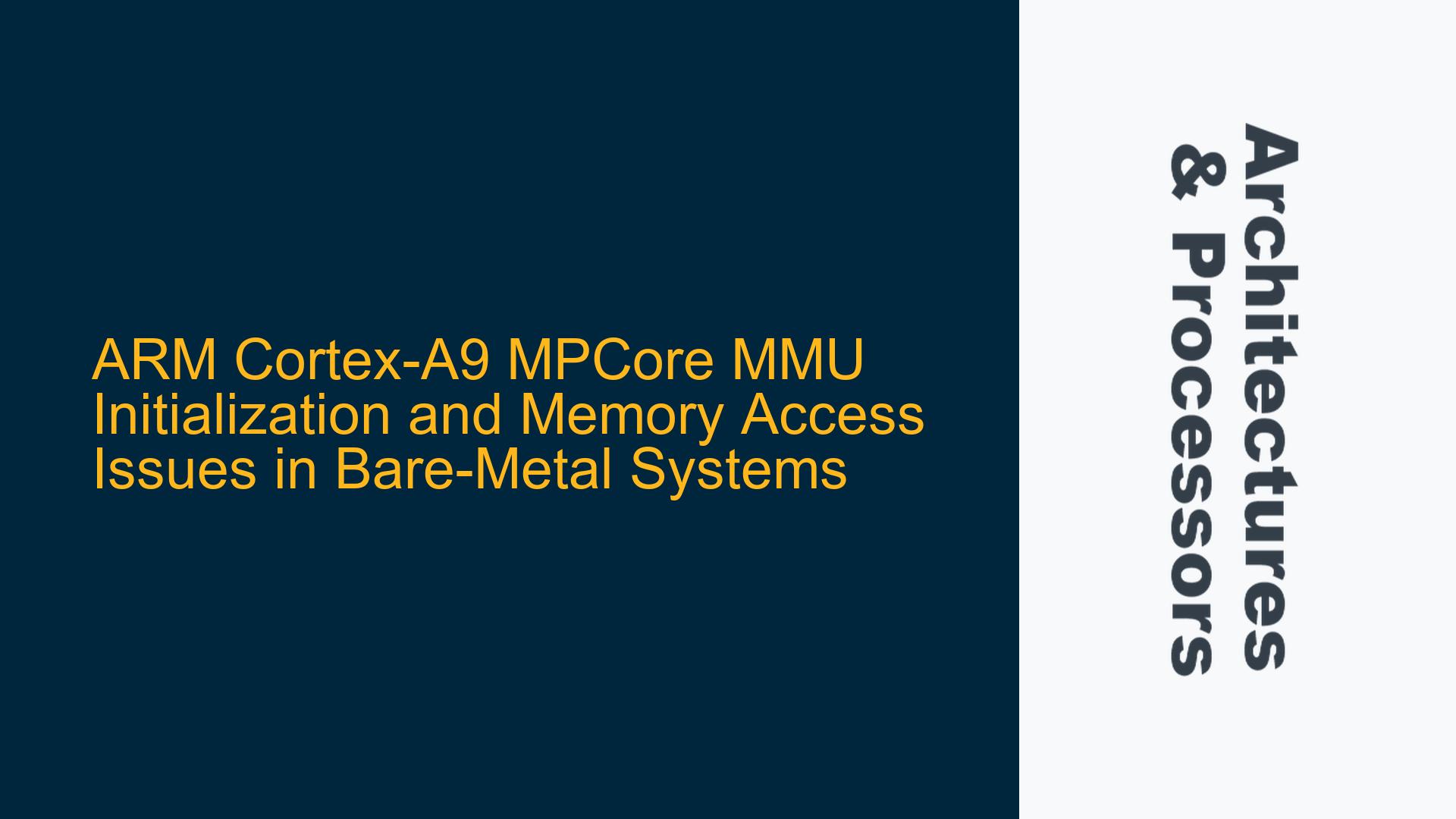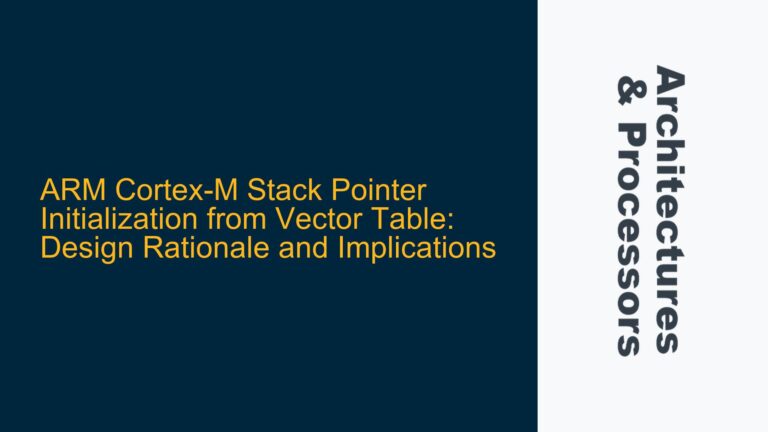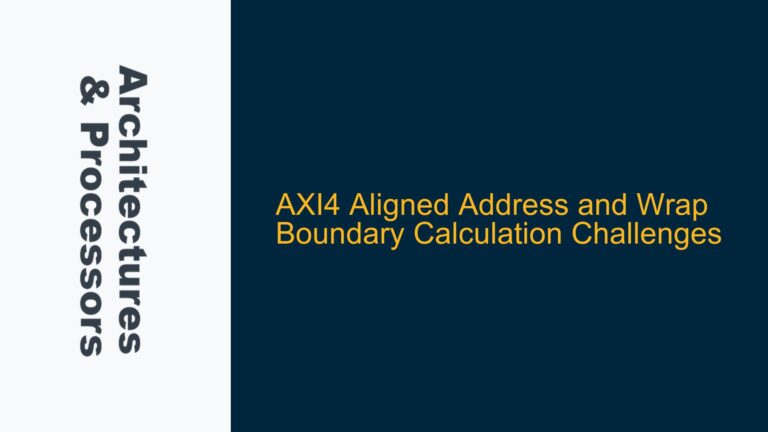ARM Cortex-A9 MPCore MMU Configuration and System Hang During Initialization
The ARM Cortex-A9 MPCore processor is a popular choice for embedded systems requiring multicore capabilities. However, configuring the Memory Management Unit (MMU) in a bare-metal environment, especially in a multicore setup, can be challenging. The primary issue discussed here revolves around the system hanging during MMU initialization, specifically at the alt_mmu_va_space_enable() function. This problem is exacerbated by the need to configure dedicated memory regions for each core, shared non-cacheable memory areas, and device memory regions.
The MMU is responsible for translating virtual addresses to physical addresses and enforcing memory access permissions. In a multicore system, each core has its own MMU, which must be configured independently. The configuration involves setting up translation tables, defining memory regions with specific access permissions, and ensuring that the MMU is enabled correctly. The system hang during MMU initialization suggests that there might be issues with the translation table setup, access permissions, or the sequence in which the MMU is enabled.
The provided code snippet shows the MMU initialization for CPU0, where four memory regions are defined: a dedicated memory area for CPU0, a dedicated memory area for CPU1 (with no access permissions for CPU0), a shared non-cacheable memory area, and a device memory area. The same initialization is performed for CPU1, with the access permissions and attributes swapped. Despite this configuration, the system hangs, indicating a potential flaw in the MMU setup or the underlying assumptions about memory access.
Missing DACR Configuration and Heap Setup Issues
One of the critical aspects of MMU initialization is the configuration of the Domain Access Control Register (DACR). The DACR controls access permissions for different memory domains, and its configuration is essential for ensuring that the MMU operates correctly. In the provided code, there is no explicit configuration of the DACR, which could lead to incorrect access permissions and system instability.
The DACR is a 32-bit register that defines the access permissions for 16 different domains. Each domain can be configured as either a client or a manager. A client domain uses the access permissions defined in the translation tables, while a manager domain bypasses these permissions, allowing full access to the memory regions within that domain. In the context of the provided code, the alt_mmu_va_space_enable() function is expected to set all 16 domains to client mode (ALT_MMU_DAP_CLIENT), which should enforce the access permissions defined in the translation tables. However, if the DACR is not configured correctly, the MMU may not enforce the intended access permissions, leading to system hangs or memory access violations.
Another potential issue is the setup of the heap. The heap is a region of memory used for dynamic memory allocation, and its correct setup is crucial for the proper functioning of the system. In the provided code, the use of malloc() to test the MMU configuration is problematic. If the heap is not correctly configured, malloc() may fail, leading to incorrect conclusions about the MMU setup. A more reliable approach would be to use direct pointer manipulation to test the MMU configuration, as this avoids the complexities of dynamic memory allocation and provides more control over memory access.
Implementing Correct MMU Configuration and Debugging Steps
To resolve the system hang during MMU initialization, several steps can be taken to ensure that the MMU is configured correctly and that the system operates as expected. These steps include verifying the DACR configuration, ensuring correct heap setup, and using direct pointer manipulation to test the MMU configuration.
Verifying DACR Configuration
The first step is to verify that the DACR is configured correctly. This involves checking that all 16 domains are set to client mode, which enforces the access permissions defined in the translation tables. The following code snippet shows how to explicitly set the DACR to client mode for all domains:
void set_dacr(void) {
__asm volatile(
"MRC p15, 0, r0, c3, c0, 0\n" // Read DACR
"ORR r0, r0, #0xFFFF\n" // Set all domains to client mode
"MCR p15, 0, r0, c3, c0, 0\n" // Write DACR
);
}
This code reads the current value of the DACR, sets all domains to client mode by OR’ing the value with 0xFFFF, and then writes the modified value back to the DACR. This ensures that the MMU enforces the access permissions defined in the translation tables.
Ensuring Correct Heap Setup
The next step is to ensure that the heap is correctly configured. This involves setting up the heap region in the scatter file and verifying that the heap is correctly initialized before any dynamic memory allocation is performed. The following code snippet shows how to set up the heap region in the scatter file:
LR_ROM 0x00000000 0x10000000 {
ER_ROM 0x00000000 0x10000000 {
*.o (RESET, +First)
*(InRoot$$Sections)
.ANY (+RO)
}
RW_RAM 0x10000000 0x20000000 {
.ANY (+RW +ZI)
}
HEAP 0x30000000 0x10000000 {
.ANY (HEAP)
}
}
This scatter file defines three memory regions: a ROM region for code and read-only data, a RAM region for read-write data and zero-initialized data, and a heap region for dynamic memory allocation. The heap region is defined as a separate memory region, ensuring that it does not overlap with other memory regions.
Using Direct Pointer Manipulation to Test MMU Configuration
Finally, to test the MMU configuration, it is recommended to use direct pointer manipulation instead of malloc(). This approach provides more control over memory access and avoids the complexities of dynamic memory allocation. The following code snippet shows how to test the MMU configuration using direct pointer manipulation:
void test_mmu_configuration(void) {
uint32_t *ptr;
// Test access to CPU0 memory area
ptr = (uint32_t *)0x00000000;
*ptr = 0xDEADBEEF;
if (*ptr != 0xDEADBEEF) {
// Handle memory access error
}
// Test access to CPU1 memory area (should fail)
ptr = (uint32_t *)0x10000000;
*ptr = 0xDEADBEEF;
if (*ptr == 0xDEADBEEF) {
// Handle memory access error
}
// Test access to shared memory area
ptr = (uint32_t *)0x30000000;
*ptr = 0xDEADBEEF;
if (*ptr != 0xDEADBEEF) {
// Handle memory access error
}
// Test access to device memory area
ptr = (uint32_t *)0x40000000;
*ptr = 0xDEADBEEF;
if (*ptr != 0xDEADBEEF) {
// Handle memory access error
}
}
This code tests access to each memory region by writing a known value to a memory location and then reading it back. If the value read back does not match the value written, it indicates a memory access error. This approach provides a more reliable way to test the MMU configuration and ensures that the memory access permissions are enforced correctly.
Debugging Runtime Errors and Device Area Issues
In addition to the steps outlined above, it is important to debug any runtime errors that occur after the MMU is enabled. These errors could be caused by incorrect memory access permissions, overlapping memory regions, or issues with the device memory area. The following steps can be taken to debug these issues:
-
Check Memory Access Permissions: Verify that the memory access permissions defined in the translation tables are correct and that they match the intended memory usage. This includes checking that the access permissions for each memory region are set correctly and that there are no overlapping memory regions.
-
Verify Device Memory Configuration: Ensure that the device memory area is configured correctly and that the access permissions are set to allow access to the device registers. This includes checking that the device memory area is marked as non-cacheable and that the access permissions allow read and write access.
-
Use a Debugger: Use a debugger to step through the code and verify that the MMU is configured correctly. This includes checking the values of the MMU registers, such as the Translation Table Base Register (TTBR), the DACR, and the Translation Table Descriptors. The debugger can also be used to monitor memory access and identify any memory access violations.
-
Check for Fragmented Identity Mapping: Ensure that the memory regions are mapped correctly and that there are no gaps or overlaps in the memory mapping. This includes checking that the memory regions are contiguous and that the memory mapping is consistent with the scatter file.
By following these steps, it is possible to identify and resolve the issues with the MMU configuration and ensure that the system operates correctly in a bare-metal environment. The key is to carefully verify the MMU configuration, ensure that the heap is correctly set up, and use direct pointer manipulation to test the MMU configuration. Additionally, debugging any runtime errors and verifying the device memory configuration are essential steps in ensuring the correct operation of the system.






